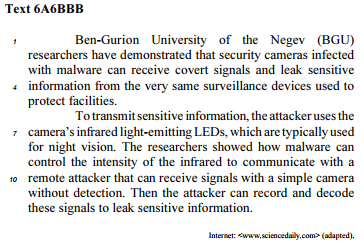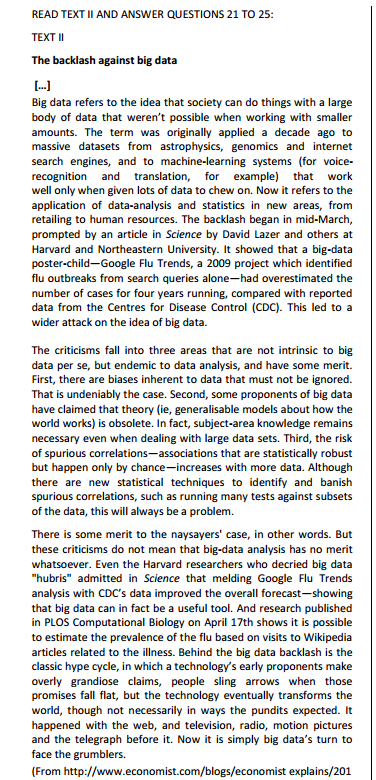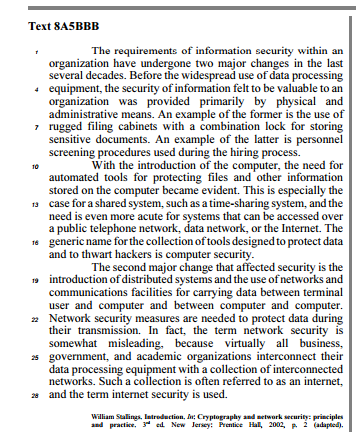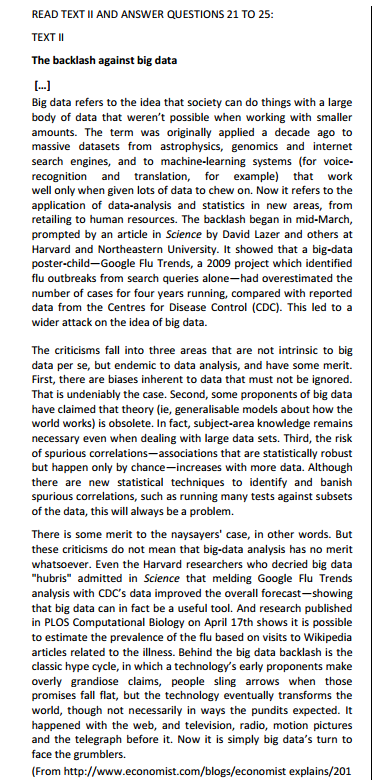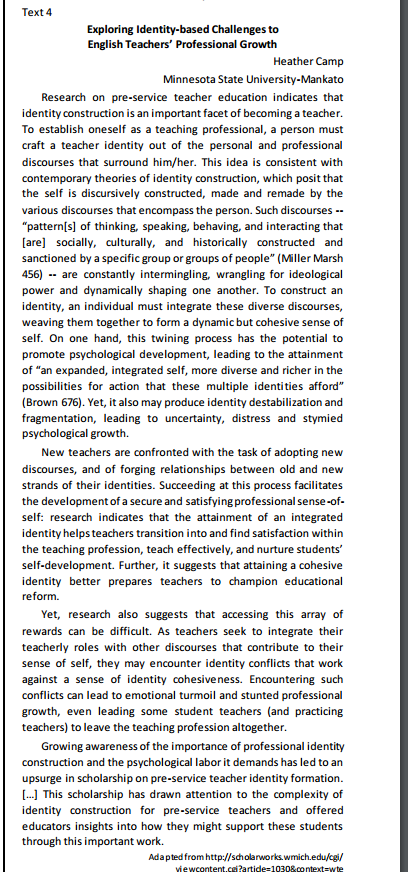
In text IV, without altering the general meaning of the sentence, "pinpoint" (l.10) could be replaced by (mark right — C — or wrong — E)
ascertain.

In text IV, without altering the general meaning of the sentence, "pinpoint" (l.10) could be replaced by (mark right — C — or wrong — E)
compare.

Considering the grammatical and semantic aspects of text IV, decide whether the following items are right (C) or wrong (E).
The expression “a bunch of" (l.45) could be replaced by a cluster of without altering the meaning of the passage.
Without altering the meaning of text 6A6BBB, the expression “covert signals" (l.3) could be replaced by

In text IV, without altering the general meaning of the sentence, "pinpoint" (l.10) could be replaced by (mark right — C — or wrong — E)
determine.

Considering the grammatical and semantic aspects of text IV, decide whether the following items are right (C) or wrong (E).
The expression “hold their tongue with" (l.54 and 55) could be replaced by uphold their dialect against without altering the meaning of the sentence.
Text 3A7AAA
Software architecture is a complex topic. Due to its
complexity, our profession has produced a variety of definitions,
each more or less useful depending on your point of view. Here is
a definition from my first book, Journey of the Software
Professional: "A system architecture defines the basic "structure"
of the system (e.g., the high level modules comprising the major
functions of the system, the management and distribution of data,
the kind and style of its user interface, what platform(s) will it run
on and so forth)".
This definition is pretty consistent with many others.
However, it lacks some important elements, such as specific
technology choices and the required capabilities of the desired
system. A colleague of mine, Myron Ahn, created the following
definition of software architecture. It is a bit more expansive and
covers a bit more ground than my original: "Software architecture
is the sum of the nontrivial modules, processes, and data of the
system, their structure and exact relationships to each other, how
they can be and are expected to be extended and modified, and on
which technologies they depend, from which one can deduce the
exact capabilities and flexibilities of the system, and from which
one can form a plan for the implementation or modification of the
system".
We could extend these definitions from the technical point
of view, but this wouldn't provide a lot of value. More than any
other aspect of the system, architecture deals with the "big picture".
The real key to understanding it is to adopt this big picture.
Moreover, while these definitions are useful, they are far too
simplistic to take into account the full set of forces that shape, and
are shaped by, an architecture. In truth, I doubt that any single
definition of software architecture will ever capture all of what we
believe to be important.
Luke Hohmann. Defining software architecture. In: Beyond
software architecture: creating and sustaining winning
solutions. Boston: Addison-Wesley, 2003, p. 1-2 (adapted)
In the first line of text 3A7AAA, the expression “Due to" could
be correctly replaced by
Read the following article and answer question based on the text.


In the excerpt “ who have failed to pick up the local languages", the expression “pick up" (paragraph 3) means:
When Text II mentions “grumblers” in “to face the grumblers”, it refers to:
In text 8A5BBB, the word “often” (R.27) can be correctly replaced by
READ TEXT I AND ANSWER QUESTIONS 16 TO 20
TEXT I
Will computers ever truly understand what we're saying?
Date: January 11, 2016
Source University of California - Berkeley
Summary:
If you think computers are quickly approaching true human
communication, think again. Computers like Siri often get
confused because they judge meaning by looking at a word's
statistical regularity. This is unlike humans, for whom context is
more important than the word or signal, according to a
researcher who invented a communication game allowing only
nonverbal cues, and used it to pinpoint regions of the brain where
mutual understanding takes place.
From Apple's Siri to Honda's robot Asimo, machines seem to be
getting better and better at communicating with humans. But
some neuroscientists caution that today's computers will never
truly understand what we're saying because they do not take into
account the context of a conversation the way people do.
Specifically, say University of California, Berkeley, postdoctoral
fellow Arjen Stolk and his Dutch colleagues, machines don't
develop a shared understanding of the people, place and
situation - often including a long social history - that is key to
human communication. Without such common ground, a
computer cannot help but be confused.
“People tend to think of communication as an exchange of
linguistic signs or gestures, forgetting that much of
communication is about the social context, about who you are
communicating with," Stolk said.
The word “bank," for example, would be interpreted one way if
you're holding a credit card but a different way if you're holding a
fishing pole. Without context, making a “V" with two fingers
could mean victory, the number two, or “these are the two
fingers I broke."
“All these subtleties are quite crucial to understanding one
another," Stolk said, perhaps more so than the words and signals
that computers and many neuroscientists focus on as the key to
communication. “In fact, we can understand one another without
language, without words and signs that already have a shared
meaning."
(Adapted from http://www.sciencedaily.com/releases/2016/01/1
60111135231.htm)
If you are holding a fishing pole, the word “bank” means a:
READ TEXT II AND ANSWER QUESTIONS 21 TO 25:
TEXT II
The backlash against big data
[…]
Big data refers to the idea that society can do things with a large
body of data that weren't possible when working with smaller
amounts. The term was originally applied a decade ago to
massive datasets from astrophysics, genomics and internet
search engines, and to machine-learning systems (for voicerecognition
and translation, for example) that work
well only when given lots of data to chew on. Now it refers to the
application of data-analysis and statistics in new areas, from
retailing to human resources. The backlash began in mid-March,
prompted by an article in Science by David Lazer and others at
Harvard and Northeastern University. It showed that a big-data
poster-child—Google Flu Trends, a 2009 project which identified
flu outbreaks from search queries alone—had overestimated the
number of cases for four years running, compared with reported
data from the Centres for Disease Control (CDC). This led to a
wider attack on the idea of big data.
The criticisms fall into three areas that are not intrinsic to big
data per se, but endemic to data analysis, and have some merit.
First, there are biases inherent to data that must not be ignored.
That is undeniably the case. Second, some proponents of big data
have claimed that theory (ie, generalisable models about how the
world works) is obsolete. In fact, subject-area knowledge remains
necessary even when dealing with large data sets. Third, the risk
of spurious correlations—associations that are statistically robust
but happen only by chance—increases with more data. Although
there are new statistical techniques to identify and banish
spurious correlations, such as running many tests against subsets
of the data, this will always be a problem.
There is some merit to the naysayers' case, in other words. But
these criticisms do not mean that big-data analysis has no merit
whatsoever. Even the Harvard researchers who decried big data
"hubris" admitted in Science that melding Google Flu Trends
analysis with CDC's data improved the overall forecast—showing
that big data can in fact be a useful tool. And research published
in PLOS Computational Biology on April 17th shows it is possible
to estimate the prevalence of the flu based on visits to Wikipedia
articles related to the illness. Behind the big data backlash is the
classic hype cycle, in which a technology's early proponents make
overly grandiose claims, people sling arrows when those
promises fall flat, but the technology eventually transforms the
world, though not necessarily in ways the pundits expected. It
happened with the web, and television, radio, motion pictures
and the telegraph before it. Now it is simply big data's turn to
face the grumblers.
(From http://www.economist.com/blogs/economist explains/201
4/04/economist-explains-10)
When Text II mentions “grumblers” in “to face the grumblers”, it refers to:
The phrase “lots of data to chew on” in Text II makes use of figurative language and shares some common characteristics with:
The use of the phrase “the backlash” in the title of Text II means the:
In the context of Text 4, the fragment “Yet, research also suggests that accessing this array of rewards can be difficult.” introduces (an)

